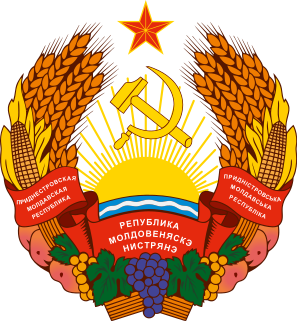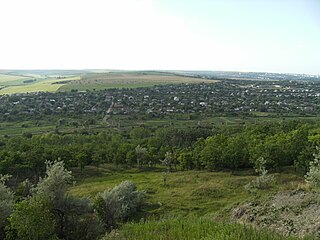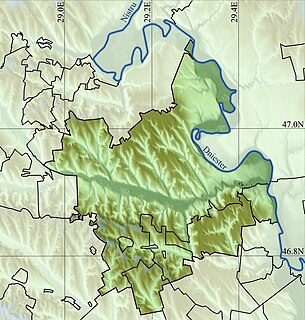
This article is about the demographic features of the population of Moldova, including distribution, ethnicity, languages, religious affiliation and other statistical data.

Tiraspol is the capital of Transnistria, a breakaway state in Moldova, where it is the second largest city. The city is located on the eastern bank of the Dniester River. Tiraspol is a regional hub of light industry, such as furniture and electrical goods production.

Transnistria, officially the Pridnestrovian Moldavian Republic (PMR), is a breakaway state in the narrow strip of land between the river Dniester and the Ukrainian border that is internationally recognized as part of Moldova. Its capital is Tiraspol. Transnistria has been recognised only by three other mostly unrecognised breakaway states: Abkhazia, Artsakh, and South Ossetia.

Bender or Bendery, also known as Tighina, is a city within the internationally recognized borders of Moldova under de facto control of the unrecognized Pridnestrovian Moldavian Republic (Transnistria) (PMR) since 1992. It is located on the western bank of the river Dniester in the Romanian historical region of Bessarabia.

Politics of Transnistria, a de facto independent state situated de jure within the Republic of Moldova in Eastern Europe, takes place in a framework of a semi-presidential republic, whereby the President of Transnistria is head of state and the Prime Minister of Transnistria is head of government. Executive power is exercised by the government. Legislative power is vested in both the government and parliament. Formally, Transnistria has a multi-party system and a unicameral parliament, called the Supreme Council. The president is elected by popular vote. The latest parliamentary elections were held in December 2010; however, they were not monitored by international organizations such as Organization for Security and Co-operation in Europe (OSCE), which has expressed doubts about the level of democracy in the region, and were not recognized by other countries.

Grigoriopol is a town in Transnistria autonomous territorial unit, Moldova. It is the seat of the Grigoriopol District of Transnistria. The city is located on the left (eastern) bank of the river Dniester at 47°09′N29°18′E, in central Transnistria. Grigoriopol is composed of the city itself, and a small village Crasnoe (Красное). The town itself had a population of 11,473 in 2004.

The Transnistria War was an armed conflict that broke out in 2 November 1990 in Dubăsari between pro-Transnistria (PMR) forces, including the Transnistrian Republican Guard, militia and Cossack units, and pro-Moldovan forces, including Moldovan troops and police. Fighting intensified on 1 March 1992 and, alternating with ad hoc ceasefires, lasted throughout the spring and early summer of 1992 until a ceasefire was declared on 21 July 1992, which has held. The conflict is sometimes known as the Moldo-Russian war in Moldova and Romania.

Camenca District is a district of Transnistria, a breakaway republic which is internationally recognized as part of Moldova. Its seat is the town of Camenca. The district contains this town and twelve communes :

The Transnistria Governorate was a Romanian-administered territory between the Dniester and Southern Bug, conquered by the Axis Powers from the Soviet Union during Operation Barbarossa and occupied from 19 August 1941 to 29 January 1944. Limited in the west by the Dniester river, in the east by the Southern Bug river, and in the south by the Black Sea, it comprised the present-day region of Transnistria and territories further east, including the Black Sea port of Odessa, which became the administrative capital of Transnistria during World War II.

The political status of Transnistria, a self-proclaimed state on the internationally recognized territory of Moldova, has been disputed since the Transnistrian declaration of independence on 2 September 1990. This declaration sought to establish a Soviet Socialist Republic that would be independent from local Moldovan authority. Following the breakup of the Soviet Union and Moldova's own declaration of independence in 1991, the Pridnestrovian Moldavian Soviet Socialist Republic (PMSSR) was transformed into the Pridnestrovian Moldavian Republic (PMR). However no United Nations member country recognizes the PMR's independence.

This is the history of Transnistria. See also the history of Europe.

Chițcani is a commune in Căușeni District, Moldova. It consists of the village Chițcani and two small villages (hamlets), Merenești and Zahorna. Chițcani is situated to the south-east of the city of Tighina (Bender). The locality, although situated on the right (western) bank of the river Dniester, is under the control of the breakaway Transnistrian authorities. On the opposite side of the river lies the city of Tiraspol.

The Romanian-language schools in Transnistria are subject to limitations by the government of Transnistria, an unrecognized breakaway region of Moldova since 1992.

Gîsca is a village near in Căușeni District, Moldova, composed of a single village with the same name, population 4,841 at the 2004 Census. The locality, although situated on the right (western) bank of the river Dniester, immediately to the south-west of the city of Tighina (Bender), in the Bessarabian, not Transnistrian part of Moldova, is under the control of the breakaway Transnistrian authorities.

Although most commonly known in English as Transnistria, the official name of the region is Pridnestrovie. Here is a detailed explanation of the names used for Transnistria, both official and unofficial, as they appear in the local languages and in English.

Varnița is a village in the Anenii Noi District, Moldova, located near Bender (Tighina). It is also considered a suburb of Bender. After the 1992 War of Transnistria, Varnița remained controlled by the government of the Republic of Moldova, while the city of Bender is controlled by the authorities of Transnistria.

A demographic history of Transnistria shows that Transnistria has been home to numerous ethnic groups, in varying proportions, over time.

This timeline of events is a chronological list of incidents and other notable occurrences related to the War of Transnistria, including events leading up to the war.

Proteagailovca is a village in the municipality of Bender (Tighina), Moldova. It had a population of 3,142 at the 2004 Census. The locality, although situated on the right (western) bank of the river Dniester, is under the control of the breakaway Transnistrian authorities. Proteagailovca is located immediately to the west of the city, and is the only other locality in the municipality, except the city of Bender itself.

Moldova–Transnistria relations are the political and economic relations between the Republic of Moldova and Transnistria, an unrecognized state between the Dniester River and Ukraine. During the dissolution of the Soviet Union, political tensions in the Moldavian Soviet Socialist Republic led to Transnistria declaring independence from Moldova, culminating in the Transnistrian War of 1992. As part of the ceasefire agreement ending the war, a Joint Control Commission composed of Moldovan, Transnistrian, and Russian forces was established to supervise the demilitarized zone which was located in the Transnistrian region. The Joint Control Commission still supervises the zone, and negotiations to resolve the dispute are ongoing. The negotiations are supported by the Russian Federation, Ukraine, the United States, the European Union, and the Organization for Security and Co-operation in Europe (OSCE).
















